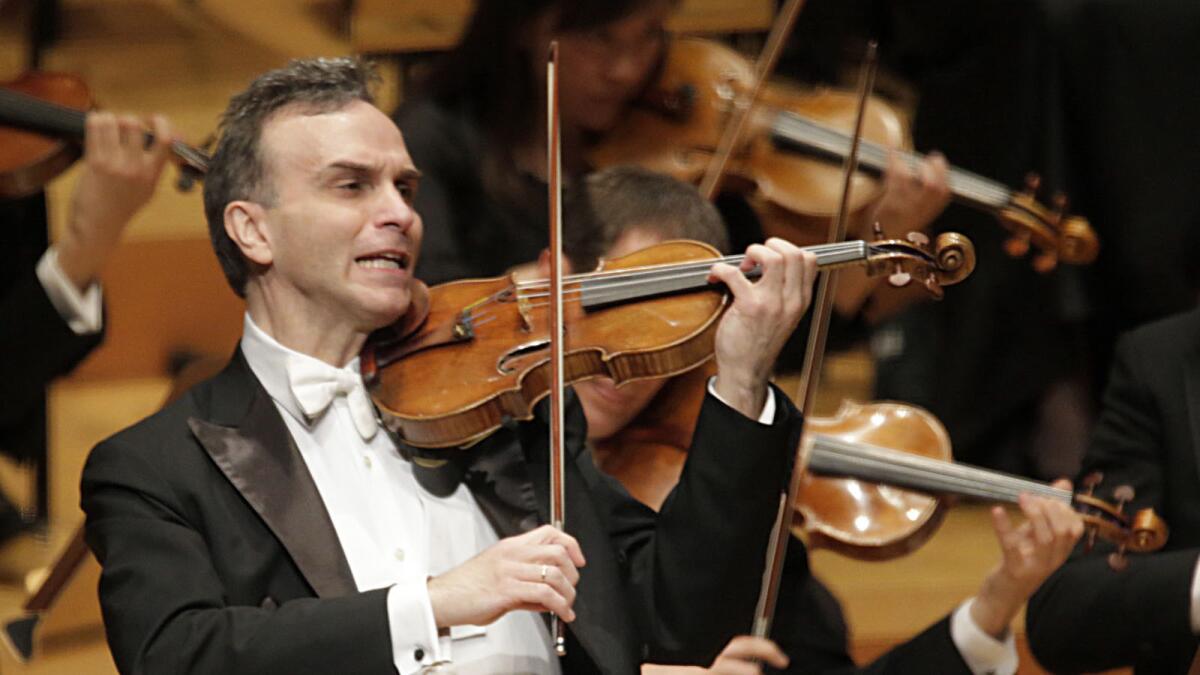Review: Gil Shaham at Disney Hall: This sound did not need a film dimension

- Share via
Few scores in music history have spoken as eloquently as Bach’s sonatas and partitas for unaccompanied violin. Completed in 1720, his set of three sonatas and three partitas are among the most intellectually and emotionally enriching works ever composed.
So why did Gil Shaham feel the need to accompany these instrumental masterpieces at Walt Disney Concert Hall on Sunday night with nearly static slow-motion films by New York video artist David Michalek?
Shaham, 44, has called his Bach project, in which he will perform all of the sonatas and partitas for unaccompanied violin, “my midlife crisis.” As he traversed one of the most extreme challenges a soloist can face, images of smiling children and adults, along with others of dancers appearing to be in a kind of suspended animation, were projected behind him on a huge screen.
Shaham had a small screen at his feet, allowing him to watch while playing. The First Sonata’s opening image set the tone: a new-born with a smiling young sister and mother. It’s a Hallmark Card moment — soothing and ingratiating.
Welcome to Bach in the 21st century. If empty seats were any indication, no wonder purists stayed away. If you go to hear Bach hoping for a momentary stay against confusion, a refreshingly cathartic exercise of concentration, or just for a respite from the head-swirling distractions of modern life, then perhaps a more undiluted recital is required.
Some people left after the first intermission (there were two); others told me they began listening with their heads down or tried to focus on Shaham.
Indeed, if you could get beyond the looming screen and distracting images, Shaham often played well. His wasn’t the most probing Bach, but it was always fluent and musical. Shaham performed from memory, using a reconfigured 1699 Stradivarius with a baroque-style bridge and bow allowing greater flexibility and a more edgeless sound.
It also allowed him to play fast without losing clarity of articulation in the exhilarating Fugue of the Second Sonata or rapid Allegro of the Third.
Only Shaham’s trademark grimace-like smile betrayed a slight case of nerves, while he occasionally stopped between sections to tune.
During the First Sonata, Shaham showed restraint in the often richly ornamented melody of the opening Adagio. Images included a girl in white pouring a pitcher of water in super slow-motion, but the viscous-looking liquid conflicted with Shaham’s delicately textured account.
In the First Partita (partitas are essentially a lively sequence of baroque dances), dancers barely moved in a kind of ecstasy of poetry in no motion. But, using minimal vibrato, Shaham’s partitas remained light on their feet.
When the image of a woman in traditional kimono with a splayed fan in each hand filled the screen, there were giggles from some in the audience. Not the best way for Shaham to begin the monumental Chaconne that ends the Second Partita. Nevertheless, the odd image was gratefully brushed aside by Shaham’s poignant reading, which grew in stature as it went along, producing some of his most gripping playing.
Shaham’s precision and endurance remained strong in the onrushing Prelude of the recital’s concluding Third Partita. He also managed the double stops of the Loure with aplomb. His cheerful reading of the concluding Gigue was characteristic of his playing all night. Generally, Shaham’s Bach interpretations inclined to spontaneity over a more profound plumbing of the music’s limitless depths.
Still, Michalek’s original films remained a puzzling distraction. The mostly literal images and faces of strangers seemed to obstruct rather than enhance one’s own impulses to wonder and reflect while listening to music of unparalleled abstract, melodic and rhythmic force.
More to Read
The biggest entertainment stories
Get our big stories about Hollywood, film, television, music, arts, culture and more right in your inbox as soon as they publish.
You may occasionally receive promotional content from the Los Angeles Times.










